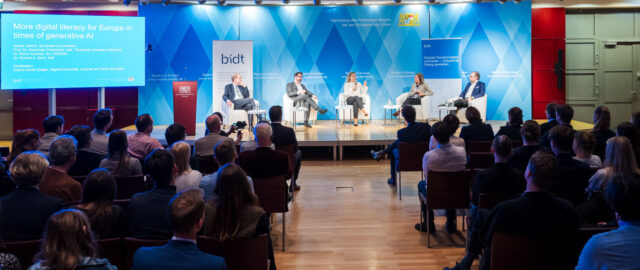Joint press release bidt/BLM:
The research project was funded by the Bavarian Research Institute for Digital Transformation (bidt) of the Bavarian Academy of Sciences and Humanities and the Bavarian Regulatory Authority for New Media (BLM).
How can opinion power be measured in the digital platform age? The research team from Johannes Gutenberg University Mainz and Ludwig Maximilian University Munich proposes replacing television-centred concentration control, which is in need of reform, with modular opinion power monitoring. Although the protocol declaration to the Interstate Media Treaty 2020 already mentions efforts to create a sustainable media concentration law, a reform has yet to be implemented. The monitoring is intended to help better capture the power of opinion in complex media environments.
In the latest “bidt policy brief”, the final publication of the research project “Measuring opinion power and diversity on the internet”, the authors — Prof. Dr Birgit Stark, Prof. Dr Carsten Reinemann, Lisa Zieringer M.A., Daniel Stegmann M.A. — outline the urgent need for media policy action.
Communication scientist Prof Dr Birgit Stark explains:
The digital transformation requires innovative solutions in order to preserve the basic principles of democratic opinion-forming. In the age of Google, Facebook and the like, the existing control instruments for measuring opinion power are outdated. With our approach to monitor opinion power, we want to make a contribution to shaping the media landscape for the future.
 Prof. Dr. Birgit Stark To the profile
Prof. Dr. Birgit Stark To the profile
The study provides an important contribution to the discussion on the necessary reform of media concentration law.
Dr Thorsten Schmiege, President of the BLM
We are delighted that the research project funded jointly with the BLM has come to a successful conclusion with clear media policy recommendations.
 Dr. Christoph Egle To the profile
Dr. Christoph Egle To the profile
Modular system also includes media use, media trust and media content
The monitoring includes all media types and media intermediaries and analyses the use, content and impact of media brands. In order to identify potential risks, it combines various dimensions of analysis and methods in a modular system. On the one hand, the aim is to obtain a picture of the use of information on current events – in particular, the extent to which access channels differ. On the other hand, it links the supply side with the user side. For example, it is possible to determine which population groups actually receive which variety of media.
The system can provide indications of threats to the free formation of opinion and promote awareness of media quality. Specific regulatory measures can also be derived from this. Overall, it aims to create a transparent basis for media policy decisions and thus ensure diversity as a prerequisite for the free formation of opinion in a rapidly changing media landscape.
Three recommendations for contemporary diversity protection
The paradigm shift called for by the researchers includes three core concerns:
- Moving away from television-centred concentration control: instead, risk control should be established by means of continuous monitoring and evaluation.
- Expansion of research infrastructures for evidence-based recommendations for action: A long-term monitoring of opinion power, for which various research institutions work together, should provide relevant knowledge for media policy decisions.
- Establishment of a holistic approach to safeguarding diversity: In the digital platform age, modern diversity safeguarding should move away from pure provider control and take into account both the diversity of content and the diversity used.
Research project
Contact persons
Press contact

Enquiries about the study

Prof. Dr. Birgit Stark
Professor of Communication and Media Convergence, Department of Journalism | JGU Mainz

Prof. Dr. Carsten Reinemann
Professor of Political Communication Research, Director of the Department of Media and Communication | Ludwig-Maximilians-Universität in Munich







